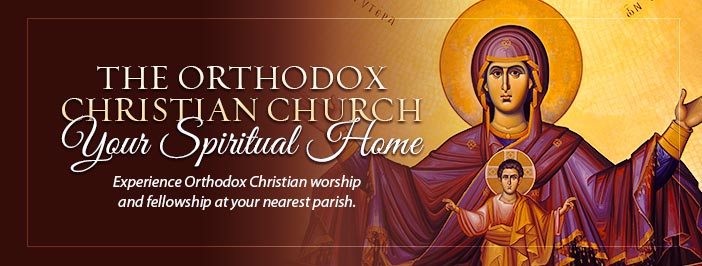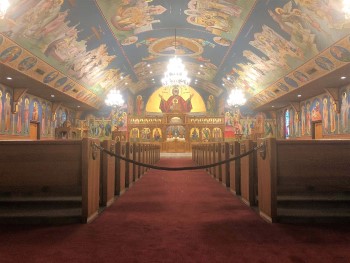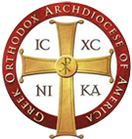Welcome to the Orthodox Christian Faith
Although we are one of the major religious groups in the world, we often find that we are not well understood by members of other faiths. The points below represent our response to some of the questions about us:
We are Orthodox Christians
Many people confuse us with Orthodox Jews, but the similarity of names is pure coincidental. Actually, Orthodox is a Greek word meaning “proper worship” and “right faith.”
You don’t have to be Ethnic to be Orthodox
Converts are welcome in our parishes, and a large proportion of the services are conducted in English.
Greek Orthodox and Russian Orthodox are the same religion. The Orthodox Church is actually a “family” of churches, consisting of many ethnic groups. Each ethnic group, however, makes use of the title “Greek” in their official title. The reasons being: 1.) It is the language of the New Testament; and 2.) The language of the Christian Faith for one thousand years, when it was one Church, was Greek. We have parishes that are Greek, Antiochian, Serbian, Ukrainian, Romanian, Albanian, etc., plus the Orthodox Church in America (OCA) which is historically Russian.
We are a Church experiencing growth
Our total membership is estimated at 250 million – and rapidly increasing, due to the religious revival in Eastern Europe. In California, and many other states, we are officially considered the fourth major faith.
We have been active in the Ecumenical Movement
As Orthodox, we feel we should do everything possible to promote Christian unity. At the same time, our adherence to Christian Tradition has sometimes made our participation difficult.
We are Catholic, but not Roman Catholic
Catholic is a Greek word that means “according to the whole.” We believe that we profess the Christian Faith in its fullness. We, therefore, are a Catholic Church. Catholic, in the sense of being “Universal,” is also attributed to Orthodox since all people may join. The Western Church (headed by Rome) was with us until 1054, when East and West split, primarily over increasing authority the Pope tried to assume.
We are Evangelical, but not Protestant
Evangelical comes from the Greek word meaning “Gospel.” We are very Gospel centered – in fact, a Gospel Book is always kept on our Holy Altar Table. But we are not Protestant, since we have never had a Reformation; our history goes back unbroken to the early Church found in the Book of Acts.
Our Official Translation of the Bible is the Original
The Orthodox Church is the only Church in Christendom that has read the New Testament in the original language since it was written. Some parts of it were actually written to churches in Greece (1 & 2 Corinthians and 1 & 2 Thessalonians).
We follow the Traditions of God, not of men
The Holy Bible itself could be described as “Tradition written down.” “Unwritten Tradition” has also been preserved in our Church, from the Apostles themselves. As St. Paul said, “…stand firm and hold to the traditions which you were taught by us, either by word of mouth or by letter” (2 Thessalonians 2:15).
We are Conservative, but not Fundamentalists
To properly interpret the Bible one must take the literal parts literally and the symbolic parts symbolically. Tradition is our guide for telling, which is which. Even the early Christians knew that Genesis and Revelation contain a lot of symbolic language.
Orthodox Church Buildings are Christian Temples
Like the early Christians, our religious practices are based on Old Testament sources, fulfilled in Christ. These include: synagogue worship; ceremonial meals (like the Last Supper); and the ritual of the Temple. Early Christian worship, as described in Revelation chapters 4 & 5, includes vestments, incense, bowing down in prayer, etc.
Our Icons (holy pictures) are not idols
Icon and idol are both Greek words – with very different meanings. An idol is literally an image of God that is “dreamed up” by human beings. By contrast, the Bible calls Christ Himself the “icon” or “image” of God seven times (example, Colossians 1:15).
Married men are ordained to the holy priesthood
Ever since New Testament times, most of our priests have had the choice to marry (See Titus 1:5-6). Priest is just a shortened form of the Greek word “Presbyter,” meaning “Elder.” We call them “father” as a natural term of respect for an elder in the Christian family (See 1 Corinthians 4:15-16).
Our Sunday Services are called the Divine Liturgy
A Liturgy is a service done by a liturgist (leitourgos) – in other words, a priest who leads his people in formal, “liturgical” worship. In New Testament Greek, Christ and St. Paul are each referred to as a “leitourgos” (Hebrews 8:1-2 & Romans 15:16). Our Liturgy is the Sacrament of the Holy Eucharist.
You are welcome to attend Orthodox Services
Visitors are frequently seen at our churches and they are welcome to come and experience Orthodox Christian worship with us. To receive Holy Communion one must be a baptized and/or chrismated Orthodox Christian, but at the end of the Liturgy, everyone is invited to join the faithful to receive blessed bread from the priest in token of Christian fellowship.

Church Design & Iconography
The Greek Orthodox Church of the Annunciation in Modesto, California was built in 1957 as a small basilica. Traditionally, Orthodox churches are built small to enhance the sense of community in worship. In 1989 the parish began a remodeling of the church sanctuary that is still in progress. The collective energy and resourcefulness of the entire Community are working to provide a spiritual atmosphere in accordance with Orthodox Christian teachings. Adhering to the Orthodox tradition, the design of the Annunciation is that of an ark, the ship that leads us to heaven. The church is divided into three parts: 1.) the Narthex; 2.) the Nave; and 3.) the Holy Altar.


The Narthex
The entrance of the church is the Narthex. This is where the Orthodox Christian prepares himself for worship by making his offering and lighting a candle as a symbol of prayer and confessing that Jesus is the Light of the world. The Light of Christ is to be reflected in the life of the believer and shared with others. We do not worship the holy pictures, we show honor and respect to the saint or saints depicted. We ask that they pray with us and for us.
The life of the Virgin Mary is depicted in the Narthex. Upon entering the church one realizes the important role of the Virgin Mary as the “handmaid of the Lord…” (Luke 1:38). Just as Christ was born through the Virgin Mary, we enter His House through her life. Within the Narthex we have five scenes of the Virgin Mary’s life: The Nativity of the Theotokos; The Parental Bond depicting Ss. Joachim, Anna, & the Virgin Mary; The Entrance of the Virgin Mary to the Temple; The Dormition of the Virgin Mary; and The Life-Giving Fountain. On the ceiling of the Narthex is the Virgin Mary depicted as the Heavenly Queen surrounded by the angelic hosts. Surrounding this icon are ten Old Testament prophets whose message relates to the virgin birth of the Messiah. They are the Prophets: Jacob; Moses; Gideon; David; Solomon; Isaiah; Ezekiel; David; Zechariah; Habakkuk.
The Nave
On entering the Nave we gather in the area where the congregation participates in the services. The arched ceiling is symbolic of the truth that God is eternal. In churches following the Gothic design there is an attempt to reach toward heaven, while the vaulted ceiling in a Byzantine church serves to bring a little of heaven down to earth. The design, as well as, the traditional adornment of the interior of our church is based on this concept. The design of our church follows early Christian tradition, and is patterned after a more or less typical village church in Greece.
The five chandeliers are made of Czechoslovakian Crystal. The four smaller chandeliers represent the four Evangelists: Matthew, Mark, Luke, and John. Their gospels serve as the Light of Christ that illumines and sanctifies all people. The large chandelier in the center of the Nave represents Christ as the Light of the world
Just in front of the center chandelier is a large icon of JESUS CHRIST, THE PANTOCRATOR, rendered in the 14th century style of Byzantine Art. The icon depicts Christ as the Almighty watching over us from His heavenly throne. He is surrounded by four angels that serve as ministers to His Will. Just below the angels are icons of the four Evangelists: Matthew, Mark, Luke, and John. In Holy Scripture the Life of our Lord and Savior Jesus Christ is recorded in the New Testament. In this church we see His life visually represented in the icons. Beginning with the Nativity of Jesus Christ and ending with the Descent of the Holy Spirit on Pentecost, we are able to visualize the life of our Lord. As our eyes descend from the ceiling we see on each side aisle sixteen Saints of the Church that remind us that when we worship, we do so in the Community of the Saints. Surrounding the inner perimeter of the church a curtain has been painted. The symbolism of this curtain is taken from Exodus 26, which describes the tabernacle. The meaning of the curtain is to symbolize a holy place protected and sheltered by God.


The Holy Altar
Separating the Holy Altar from the Nave is the Iconostas (Icon Screen) which symbolizes the curtain in the Temple in Jerusalem that separated the people from the Holy of Holies. Our Iconostas is made of Japanese oak and was handcarved on the island of Crete with different Christian symbols. The icons shown here exist to show our unity with Christ, His Mother, the Angels, and Saints.
There is a traditional order to the placement of the icons that adorn the Iconostas. Facing the Holy Altar, to the right of the Royal Entrance (the Royal Gates close off that area), is the icon of Christ and next to it , that of St. John the Baptist. To the left of the Royal Entrance is the icon of the Holy Mother of God (Theotokos) holding the Christ Child and next to it the icon to which our parish is dedicated, the Annunciation of the Virgin Mary. It is the practice that this icon may vary from one Orthodox church to another depending on the Saint or event in the Lord’s life in whose honor the church has been named. On either side of these icons are doors with depictions of the Archangels Michael (left side) and Gabriel (right side). These doors bear the icons of the Archangels who guard the entrance to the Holy Altar, symbolic of God’s Kingdom, and are used by the acolytes (Altar servers) to exit and enter the Holy Altar. The Royal Entrance, mentioned above, is used only by the ordained clergy, Bishops, Priests, or Deacons, to enter or exit the Holy Altar. Over the Royal Entrance is the icon of the Last Supper, reminding us that our participation in the Divine Liturgy places us at that sacred event. The 14 smaller icons depict the 12 apostles including St. Paul and his disciple, the St. Titus, the first Bishop of Crete (See the Epistle of St. Paul to Titus).
The holiest place in our church is located behind the Iconostas. Through the Royal Entrance one sees the Holy Altar Table. Made of marble, it represents the Heavenly Banquet Table the Kingdom of God. Placed in the center is the Holy Tabernacle for the Reserved Sacrament of Holy Communion and the eternal vigil light signifying the presence of our Lord and Savior Jesus Christ. In front of this is the Book of the Holy Gospels, a blessing Cross, and four candlesticks. Directly behind the Holy Altar Table stands a Cross with an icon of the crucified Christ. To the left of the Holy Altar Table is the Table of Oblation where the holy utensils (the communion chalice, paten, etc.) are kept, and where the bread and wine are prepared for the celebration of the Holy Eucharist. The icon in this niche depicts the Nativity of Christ. To the right is the Table of Service. It is here that the priest will place items needed for various services. The icon in this niche depicts Jesus Christ in Extreme Humility.
Above the Holy Altar the icon of the Mother of God is located in the Apse. This icon of the Virgin Mary with her arms outstretched and Christ appearing within her is called the “Platytera.” The Virgin Mary is the example for the entire assembly of believers who choose to live Christ-centered lives. The term “Platytera” is taken from one of the hymns of the Church which refers to the womb of Mary as “wider (platytera) than the heavens” because she gave birth to the Son and Word of God, Who is infinite and eternal, yet entered time and human history as a man (John 1:1-14). Depicted also are angels who worship in awe the mystery of the Divine Incarnation. Below the apse are six icons depicting Saints and Fathers of the Church, all of whom were bishops and shepherds who served in faithful imitation of Christ, the Great High Priest and Shepherd of the Church.
The area in front of the Iconostas is called the Soleas. This area serves as the place where baptisms, weddings and other sacraments are performed. Located to the right in this area is the Bishop’s Throne symbolic of Christ as the High Priest present at all services. Next to the Bishop’s Throne is the Chanter Stand where chanters and readers will assist during the services. To the far left is a woodcarved Cross with an icon of the crucified Lord. Next to the Cross is a woodcarved Ciborium symbolic of the Tomb of Christ. Next to it is the pulpit which symbolizes the stone that was rolled in front of the Tomb of Christ. It was there that the angels proclaimed to the myrrh-bearing women the Good News of the Resurrection of Jesus Christ.
More About Icons
The Orthodox Church calls for the elaborate use of symbolism and iconography in the interior decoration of the church building. The style of iconography follows typical Byzantine traditions. To the eye of Western Christians accustomed to the religious art of the Renaissance, Byzantine Art sometimes appears austere. For Orthodox Christians, however, there was a reason for developing this style. Icons are not simply portraits representing people, but graphic presentations of spiritual truths. They remain unmoved, formal, almost unreal, only a hint of emotion appearing on the face of figures. Icons are not intended to evoke emotional response as much as understanding and wisdom. Icons are symbols, not idols. Icons are venerated, not worshipped. When we venerate icons the honor is directed to Christ or to the Saint depicted on the icon, not to the wood, paint, or colors of the icon.
In the Orthodox Church the icons bear witness to the reality of God’s presence with us in the mystery of faith. The icons are not meant to be human pictures, but visual aids to contemplation and prayer. We are to look beyond the external and deep into the spiritual meaning of living the Christian life. Icons are the witnesses of the presence of the Kingdom of God to us, and so our own presence to the Kingdom of God in the Church. It is in the Orthodox Christian Faith that icons are not only permissible, but are spiritually necessary because “the Word became flesh and dwelt among us” (John 1:14). Christ is truly man and, as man, truly the “icon of the invisible God” (Col. 1:15, 1 Cor. 11:7, 2 Cor. 4:4).
The power of icons is not mechanical or magical, but spiritual. It is a working of God’s grace in the act of a personal expression of faith and through the intercessory prayers of the Saints who live in God’s glory. Icons teach us about Christ and His ministry, as well as, about the Saints and their record of faith. As sacred art, icons are windows into heaven: they seek to symbolize the transfigured cosmos and the victory of redeemed creation by the glory of Christ. In the words of St. John of Damascus:
“The icon is a song of triumph, and a revelation, and an enduring witness to the victory of the Saints”.



